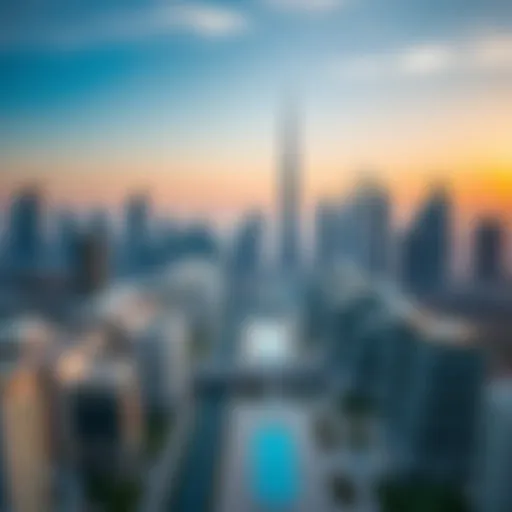Elevating Balcony Design in Dubai: A Cultural Insight
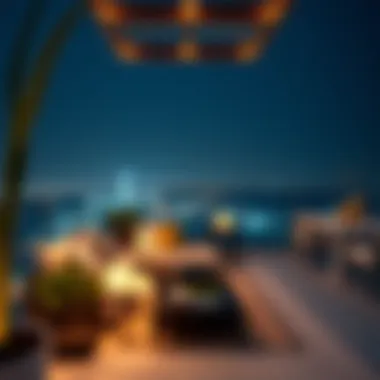

Intro
Dubai is a city where dreams meet reality, where the sky scrapers touch the clouds, and the vibrancy of life spills over into every nook and cranny. Amidst the bustling streets and the serene sands, balconies stand as gateways to outdoor sanctuaries, inviting residents to soak in the spectacular sunsets and the architectural wonders of this dynamic metropolis.
Balcony design in this emirate isn’t merely about aesthetics; it reflects a rich tapestry woven with cultural influences, innovative architectural trends, and practical considerations that cater to the local climate. Investors and homeowners alike find value in these outdoor spaces, as they not only enhance the living experience but also add considerable worth to properties in Dubai's competitive real estate market.
This exploration aims to illuminate the multifaceted aspects of balcony design, tailored specifically to the unique environment and lifestyle of Dubai. By delving into the market trends, investment strategies, and essential elements of functional yet beautiful balconies, this guide serves as a compass for those navigating the vibrant waters of Dubai's property scene.
In the pages that follow, readers will discover how to successfully blend aesthetics and functionality, ensuring their outdoor spaces become cherished retreats. Understanding the cultural context, embracing innovative materials, and recognizing the pressing need for climate-conscious design are just a few of the areas we will cover. So, let's embark on this comprehensive exploration, uncovering the art of balcony design in one of the most spectacular cities in the world.
Understanding the Importance of Balcony Design
In a city like Dubai, where the skyline is a blend of architectural marvels and cultural legacies, balcony design emerges as not just an aesthetic addition but a crucial element of residential living. Balconies serve multiple purposes; they connect indoor spaces to the vibrant outdoor environment, making them a cardinal feature for any homeowner or investor to consider. When designing a balcony, one must appreciate its potential to enhance not only the living experience but also the property’s market appeal.
Cultural Significance of Balconies
In many cultures, balconies are more than mere architectural features; they symbolize a connection to the surrounding world. In Dubai, the balcony serves as a stage for cultural expression. They often provide stunning views of the breathtaking skyline, deserts, and waterfronts, allowing residents to enjoy the city's beauty while sipping on a cup of Arabic coffee.
Moreover, balconies play a role in social settings, offering spaces for gathering and relaxation. In a city where outdoor living is as vital as indoor life, balconies bridge personal space and the communal atmosphere of Dubai, enabling residents to partake in cultural festivities or simply enjoy the dynamic pulse of the city from the comfort of their home.
Balconies as Extensions of Living Space
A well-designed balcony effectively expands usable living space, offering versatile utility beyond its square footage. For instance, it can become a quiet sanctuary for reading, a breezy dining area, or even a small garden retreat immersed in greenery. Homeowners can personalize this space to suit their tastes, creating a reflection of their lifestyle.
- Functional Use: Balconies facilitate outdoor furniture placement, like lounge chairs, tables, or hammocks, allowing for leisure activities that would otherwise be confined indoors.
- Visual Appeal: They accentuate the architecture of the building, appealing to potential buyers and tenants. A creatively outfitted balcony can be a decisive factor for those searching in the competitive real estate market of Dubai.
- Health Benefits: Regular exposure to sunlight and fresh air has been linked with numerous health benefits. In hot climates, evenings on a balcony can prove refreshing and rejuvenating.
In a nutshell, balconies hold an intrinsic significance in Dubai, enhancing quality of life by combining cultural values with functional design. As we explore further sections in this article, it becomes clearer how this humble extension plays a pivotal role in the overall living experience and property value in the region.
"Balconies are not just add-ons; they enrich lifestyles and elevate the essence of home living."
For more information about architectural designs in Dubai, you can check out Wikipedia.
Architectural Trends in Dubai
Understanding architectural trends is vital for anyone considering balcony design in Dubai. The local landscape is a blend of modernity and nostalgia, where contemporary influences intermingle with traditional elements, making the balcony a canvas for expression tailored to the city's unique character. As the real estate market flourishes, knowing these trends can help both investors and homeowners make informed decisions that enhance the value and appeal of their properties.
Contemporary vs. Traditional Balconies
The distinction between contemporary and traditional balconies in Dubai offers a glimpse into how architectural styles evolve while remaining rooted in cultural significance.
Contemporary balconies often feature sleek designs with minimalistic lines and an emphasis on functionality. Materials like glass and steel are common, providing unobstructed views of the skyline. For homeowners, opting for a contemporary look means embracing modern design philosophies where less is more. This trend is particularly evident in high-rises and luxury apartments, reflecting a lifestyle focused on sophistication and convenience.
For instance, in downtown Dubai, many new developments like the Burj Khalifa incorporate expansive glass balconies that allow residents to enjoy the stunning vistas without compromising on style. Balconies transform into an extension of living spaces, often featuring outdoor furniture designed for comfort and style, making them perfect for social gatherings or quiet evenings.
Traditional balconies, on the other hand, draw inspiration from various historical styles that reflect the rich heritage of the region. These balconies may include intricate wooden carvings, wrought iron railings, and tiled flooring, common in older neighborhoods like Al Fahidi. They often project an inviting atmosphere conducive to family interactions and neighborly conversations.
While traditional designs harken back to a time when community bonds were strong and architecture served functional as well as decorative purposes, contemporary styles often prioritize privacy and exclusivity. Striking a balance between the two can yield balconies that not only stand out aesthetically but also cater to the residents’ lifestyle needs.
Influence of Climate on Design Choices
The harsh climate of Dubai significantly shapes the design choices of balconies. With soaring temperatures, unyielding sun, and sporadic sandstorms, it becomes crucial to prioritize materials and construction techniques that withstand these elements.
First and foremost, the use of weather-resistant materials is non-negotiable. Balconies often integrate composite materials that prove resilient against fading and wear. For example, composite decking combines aesthetic appeal with durability, resisting the rigors of seasonal changes without requiring extensive maintenance.
Secondly, the orientation of the balcony plays a crucial role in climate adaptation. Balconies that face south or west may benefit from shade structures or pergolas to reduce heat exposure during peak sunlight. This not only preserves the space's usability, making it more enjoyable year-round, but also lowers energy costs associated with cooling interior spaces.
“Designing balconies in Dubai isn't just about aesthetics; it involves a strategic approach towards maintaining comfort while embracing the outdoors.”
In addition, the incorporation of green landscaping and vegetation can further mitigate the effects of climate. By implementing vertical gardens or using shade-providing trees in clever arrangements, homeowners can create micro-climates that enhance the balcony’s serenity while staying connected to nature.
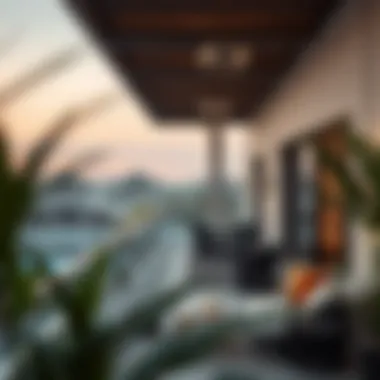

Thus, when considering balcony design in Dubai, understanding these architectural trends rooted in climate and cultural influences becomes indispensable. This knowledge not only satisfies aesthetic ambitions but also accounts for the functional demands typical of living in this vibrant desert city.
Key Design Elements
Balcony design is not just about aesthetics; it's about crafting an outdoor experience that aligns with the local culture and climate. The importance of key design elements in balcony creation in Dubai is paramount. Proper attention to material selection, color schemes, and safety features can dictate how enjoyable and functional a balcony remains over time. Homeowners and investors alike must understand these elements to ensure their spaces are both appealing and practical.
Material Selection
Wood
Wood brings a certain warmth that few other materials can match. It's a timeless choice often associated with a sense of comfort and natural beauty. In a place like Dubai, using treated woods is essential due to the hot climate. Treated varieties of woods like teak or mahogany resist moisture and withstand sweltering temperatures. However, wood does have its drawbacks; it requires regular maintenance to avoid wear and damage from the elements. This upkeep can be more intensive than other materials, but many find the appeal of wood outweighs the cons. As an eco-friendly option, wood adds a rustic charm that resonates with many designs.
Metal
When thinking of metal for balconies, aluminum frequently comes to mind. It’s appreciated for being lightweight, yet durable. Metal balconies can withstand harsh weather conditions without much hassle. One of the key characteristics is that they provide modern minimalism, fitting seamlessly into contemporary architecture. Still, the downside of metal can include heat retention. In Dubai’s extreme temperatures, a metal balcony might feel like a frying pan underfoot. Proper treatments or finishes can help mitigate this, but it’s something to keep in mind.
Glass
Glass has become increasingly popular for balcony designs, you know why? Because it offers unobstructed views, allowing residents to feel part of the skyline while also maximizing natural light. Tempered glass provides safety without sacrificing style. It’s often seen as the go-to for modern designs due to its sleekness and ability to create an airy environment. However, it requires upkeep to maintain clarity and might not be the best choice for those who prioritize privacy. With the right design, glass can be both a feature and a functional element; still, it’s a careful balancing act.
Composite Materials
Composite materials represent the best of both worlds, blending numerous elements to create a hybrid offering unique benefits. They come in various styles and can mimic wood, all while boasting greater durability and low maintenance needs. They do not warp, splinter, or fade the way some natural materials might. This makes composite a popular choice for busy homeowners who want a chic look without heavy upkeep. However, compared to traditional materials, they might lack that authentic feel that many discerning buyers crave.
Color Schemes and Aesthetics
The colors you choose for a balcony can dramatically influence its mood and functionality. Bright colors provide energy and vibrancy, while muted tones create calm and serenity. In a city like Dubai, where sunlight is abundant, lighter colors can reflect heat, keeping the space cooler. Homeowners should pair these considerations with their personal style—something lush and vibrant might suit one resident, while another might prefer a minimalist palette. Harmonizing color with surrounding architecture can also enhance the visual appeal, making balconies feel like integral parts of the homes they’re attached to.
Balcony Railings and Safety Features
The safety of your balcony should never be an afterthought. Railings serve as both a safety feature and a design element. They come in various styles; glass railings can provide visibility without obstructing views, while steel railings might add a sturdy, modern twist. Local building codes—critical to consider—often dictate certain heights and structural elements to ensure safety. A well-conceived railing not only protects but also complements the overall design, stationing itself as a prominent feature rather than merely a necessity.
"Safety features should enhance, not detract from the beauty of a balcony design."
In summary, the key design elements of balconies in Dubai not only cater to the vibrant personality of the city but also respond to its unique environmental and cultural challenges. Each material and aesthetic choice can play a role in whether a balcony becomes a favorite gathering spot or a space that fails to deliver the intended pleasure and comfort.
Functionality and Practical Considerations
Understanding how a balcony serves practical functions goes beyond mere aesthetics; it is essential for maximizing the value and utility of outdoor living spaces in Dubai. A well-thought-out balcony design not only offers a spot for relaxation but also integrates seamlessly into the overall architecture of a home, making it a functional extension of the living area. As real estate evolves in this vibrant city, investors and homeowners alike must recognize how effective functionality and practical considerations drive balcony designs to meet daily needs and enhance quality of life.
Balcony Layout and Space Optimization
Balcony layout plays a pivotal role in creating a space that feels expansive rather than confined. Consideration of how to maximize use of every square meter can lead to design choices that make a considerable difference. For instance, L-shaped balconies can create cozy corners for seating, while larger rectangular designs might be perfect for dining arrangements.
Adequate zoning is vital as well; separating lounging areas from dining spots can ensure a harmonious environment where multiple activities can occur without clutter. A nifty trick is to involve folding or stackable furniture which can be stored away when the space is not in use. This approach not only contributes to a clearer aesthetic but also helps maintain the areas functional. Using vertical space by incorporating wall-mounted storage can further elevate this layout strategy, allowing for plants and decor to adorn the balcony without taking up much-needed floor space.
Weatherproofing and Maintenance Needs
A balcony in Dubai faces unique weather challenges that necessitate careful planning in design and materials. Consequently, effective weatherproofing becomes non-negotiable. This means selecting materials and finishes that withstand high temperatures and occasional storms. For instance, opting for high-quality non-slip tiles can mitigate heat retention while providing safety underfoot, particularly in the sweltering summer months.
Maintenance isn't a burden when the right choices are made from the start. With weatherproofing measures in place, less upkeep is required, allowing for more time to enjoy the outdoors rather than scrambling to repair damages caused by fluctuations in climate. Homeowners should regularly assess their balcony, ensuring it remains in prime condition without the hassle of extensive repairs.
The Role of Landscaping
Landscape design serves a crucial function in balcony aesthetics and practicality. A thoughtful approach can enhance comfort and contribute positively to the overall atmosphere of the space. Incorporating greenery can transform a simple balcony into a small sanctuary.
Plant Selection
Plant selection is significant because it directly influences both the aesthetics and the environmental impact of a balcony. Selecting drought-resistant plants ensures that less water is used, which is essential in an arid climate like Dubai's. Succulents and cacti are prime examples of plants that require minimal maintenance while offering striking visual appeal.
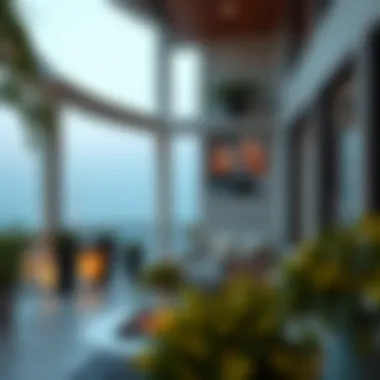

On another note, indoor-outdoor integration is also facilitated by selecting plants that act as natural barriers, effectively providing privacy without blocking light. This characteristic makes plants like tall grasses or dwarf trees fantastic choices. However, it's important to consider that heavy plants may require additional support due to the weight.
Vertical Gardens
Vertical gardens represent a creative solution to limited space. By utilizing vertical planting systems, balconies can accommodate numerous plant species without requiring additional floor area. This way, a homeowner can cultivate herbs, flowers, or climbing plants that thrive well in balconies with sufficient sunlight.
The main charm of vertical gardens lies in their ability to improve air quality and add charm to the space through layers of textures and colors. Yet, they do demand consistent maintenance to ensure plant health; regular watering and weeding are non-negotiable in keeping the vertical garden thriving.
Hardscaping Features
Hardscaping features encompass all non-plant elements of balcony design, including decking materials, paths, and seating structures. Introducing hardscaping can create functional zones while also providing durability against the elements. For example, a stone pathway can guide visitors through a zone of loungers, while raised beds can delineate areas for potted plants.
The efficiency of hardscaping lies in its longevity and resistance; high-quality materials can withstand intense sunlight and sudden rain without suffering significant deteriorations. However, one must bear in mind budgeting, as the installation costs can escalate depending on the material choices — sometimes natural stones can come at a premium price.
Balcony design in Dubai is a blend of art and functionality, calling for careful consideration of layout, weatherproofing, and landscaping. By keeping these aspects in focus, homeowners and investors can ensure that balconies serve as inviting spaces that weather the storms and seize the sunlight.
Innovative Balcony Ideas
In the ever-evolving landscape of Dubai's architecture, balcony design has transcended its traditional purpose, adopting a fresh perspective where innovation plays a pivotal role. This shift not only reflects modern aesthetics but also caters to practical needs, enhancing the living experience while addressing local climate challenges. The significance of incorporating innovative ideas in balcony design makes spaces more functional, sustainable, and inviting. With the right blend of creativity and technology, balconies can become a true extension of one’s living area, enhancing both the property’s value and the quality of life for its users.
Smart Technologies in Balcony Design
Smart technologies are revolutionizing the way we view and utilize balcony spaces. Home automation has moved beyond interiors and is trickling into outdoor areas. For instance, integrating smart lighting systems can allow homeowners to adjust lighting via smartphone applications or voice commands, ensuring that every corner is well-lit for evening gatherings.
Moreover, sensors can control elements such as heating lamps or misting systems, making it comfortable to enjoy the balcony during warmer months. The convenience of smart irrigation systems further enhances a balcony garden, allowing plants to be watered automatically, based on weather conditions. The primary benefit of utilizing these technologies is increased efficiency and comfort, making balconies not just outdoor spaces but environments compatible with modern lifestyles.
Eco-friendly Design Approaches
As sustainability becomes increasingly critical, eco-friendly design approaches for balconies are gaining traction. Utilizing renewable materials for flooring, such as bamboo or reclaimed wood, reduces the ecological footprint. Furthermore, incorporating energy-efficient solar panels for lighting can lessen reliance on traditional electricity sources.
Green roofs are also an impactful trend, providing insulation, reducing heat capture, and promoting biodiversity. Residents who opt for these designs not only contribute positively to the environment but also experience lower energy bills and improved air quality right outside their homes. Ultimately, an eco-friendly balcony harmonizes urban living with nature, a truly innovative concept for the future of Dubai’s residential properties.
Incorporating Outdoor Living Features
To fully utilize balcony spaces, incorporating outdoor living features is essential. These such elements can transform a simple balcony into an inviting retreat.
Outdoor Kitchens
Outdoor kitchens are becoming increasingly popular as they expand culinary experiences beyond the confines of indoor spaces. They allow for social gatherings centered around cooking, offering a unique setting for barbecues and family dinners. A key characteristic that makes outdoor kitchens appealing is their ability to provide comfort and convenience; built-in grills and refrigeration units ensure that everything needed for a meal is at hand.
Unique features, such as a bar counter or even pizza ovens, can enhance the outdoor cooking experience. However, potential disadvantages include added maintenance and the need for weatherproof materials to ensure longevity. Overall, outdoor kitchens are a fantastic way to embrace the outdoors while enjoying the luxury of a modern cooking environment.
Seating Arrangements
Seating arrangements are another vital aspect of outdoor living that enhances balcony enjoyment. The right kind of seating can make a balcony feel like an extension of the home, perfect for relaxation or socializing. Comfortable furniture, including lounge chairs, hammocks, or built-in benches, provides a space to unwind or entertain guests.
The key characteristic of a well-thought-out seating arrangement is flexibility; movable chairs can be easily reconfigured depending on the occasion. By incorporating cushions made of weather-resistant fabric, seating becomes inviting and functional for year-round use. However, overloading the space with too much furniture may lead to a cramped feel, which is an essential consideration for homeowners.
Lighting Solutions
Lighting solutions play a crucial role in creating the right ambiance for any outdoor space. The effective use of lighting can extend the usability of balconies well into the night. Options like string lights, lanterns, and built-in LED fixtures can create a warm atmosphere that draws people outside.
A key characteristic of thoughtful lighting design is versatility; homeowners can select adjustable fixtures that change intensity based on the mood or time of day. When executed properly, lighting not only enhances safety but also accentuates architectural features and plants. One drawback could be the initial investment in higher-quality outdoor lighting solutions, yet the transformation in the evening ambiance can be well worth the cost.
By exploring innovative concepts in balcony design, every homeowner can craft an outdoor space that is not only practical but also a reflection of personal style, all within the stunning backdrop of Dubai.
Regulatory Considerations
When diving into balcony design in Dubai, it’s essential to navigate the waters of regulatory considerations. Not only do these regulations safeguard residents, they also uphold aesthetic standards throughout the city. Living in a place like Dubai, known for its skyscrapers, it's critical that balconies adhere to building codes that ensure safety, function, and harmony with the urban landscape.
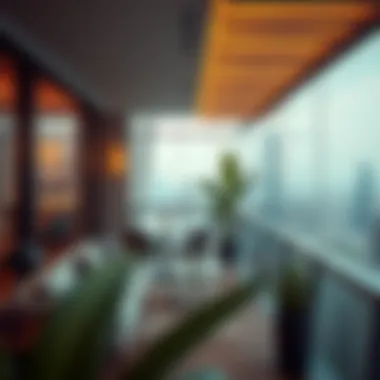

Building Codes Affecting Balcony Design
Building codes can be thought of as the blueprint for safety and structural integrity. They govern every element of balcony construction, from height requirements to load-bearing specifications. Each city, municipality, or even individual development may have its own set of codes, but common regulations often include:
- Weight Limits: Balconies must be designed to support certain loads, including furniture and potential gatherings of people, which aligns with Dubai's vibrant social culture.
- Material Specifications: The use of materials is often specified to meet both aesthetic and safety standards. For instance, balconies overlooking busy streets might require stronger railing materials to prevent accidents.
- Dimensions and Projections: Codes specify sizes and how far balconies can protrude from buildings, ensuring they don't infringe on the view or light of neighboring units.
By adhering to these codes, designers not only comply with legal requirements but also contribute to an environment where safety meets elegance. Failure to comply can usually lead to fines, additional construction time, or in the worst case, the demolition of non-compliant structures. Understanding these regulations allows homeowners and developers to create spaces that are safe, functional, and visually appealing.
Permit Requirements for New Balconies
Obtaining permits can feel like navigating a labyrinth, but it's a necessary step in creating your perfect balcony. The process usually involves multiple steps:
- Initial Applications: Before construction begins, homeowners or developers must submit detailed plans to local authorities. This includes designs, intended materials, and information about the structural integrity of the planned balcony.
- Review Process: The submitted plans undergo a review period, where officials evaluate aspects like safety, community impact, and adherence to building codes.
- Approval or Revisions: If the plans meet all requirements, an approval is granted. If not, revisions will be necessary, ensuring that the balcony will harmonize with both the building's structure and the surrounding environment.
- Final Inspections: After craftsmanship is complete, an inspection confirms that the balcony adheres to the approved designs and codes.
These permits are not just bureaucratic hurdles; they serve vital roles in maintaining safety and community standards. Especially in Dubai, where aesthetics are intertwined with functionality, following the permit process is about ensuring that each balcony complements its surroundings while also offering safety and the pleasure of outdoor living.
In summary, compliance with building codes and obtaining necessary permits is pivotal for successful balcony design in Dubai. These processes assist in creating safe, viable, and artistically appealing outdoor spaces that reflect the city's architectural spirit.
Visual Inspiration for Balcony Designs
When contemplating balcony design in Dubai, visual inspiration plays a crucial role in the creative process. It acts like a spark that ignites both imagination and functionality. A well-designed balcony not only serves as an outdoor extension of the home but also acts as a canvas where aesthetics meet practicality. This subset of design encourages homeowners and developers alike to envision innovative spaces that resonate with the vibrant culture of the region while also considering the local climate.
A balcony is not merely a platform; it’s a lifestyle choice. It reflects personal taste and enhances the overall living experience. Minimalist designs can provide a serene escape, while vibrant, colorful elements may emphasize a more lively ambiance. Each design choice is a reflection of the homeowner’s personality and the cultural influences prevalent in Dubai, from modernity to traditional styles. This creates a unique tapestry of options that can inspire potential homeowners.
Here are some key considerations and benefits when sourcing visual inspiration:
- Embracing Local Culture: Many designs incorporate elements that are deeply rooted in Arabian architecture and aesthetics.
- Functional Use of Space: Consideration for how the balcony will be used—be it for leisure, gardening, or dining—can inform visual decisions.
- Climate Adaptability: Inspiration should also focus on designs that can hold up under Dubai's scorching sun and occasional rains.
- Innovative Materials: New materials and building techniques can transform traditional designs into modern marvels without forfeiting their cultural roots.
"A balcony designed thoughtfully can become a delightful refuge, listening to the whispers of the city while offering a refreshing retreat from the hustle and bustle."
Case Studies of Notable Balconies in Dubai
Exploring case studies of notable balconies in Dubai provides insight into how different designs cater to specific needs and styles. For instance, the balconies at the Burj Khalifa showcase how elevated perspectives can be complemented with elegant designs. These spaces blend luxury with breathtaking views, creating an exclusive experience.
Consider the luxurious balcony areas of the Jumeirah Beach Residence. Here, designers focus on making leisure a priority, with lounge areas that encourage socialization. The use of textiles and ambient lighting transforms the space into a desirable nighttime retreat.
Some key highlights from these examples include:
- Proximity to Landmarks: Balconies often enhance views of Dubai's iconic skyline, making location a crucial factor in design.
- Sustainable Elements: Several case studies incorporate greenery, which not only beautifies but helps in cooling the spaces naturally.
- Personalization Opportunities: These balconies allow for many styles—from contemporary chic to classical elegance—offering homeowners the flexibility they seek.
Balcony Design Trends from Architecture Firms
The trend of balcony design is continually evolving, influenced by various social and environmental factors. Recently, leading architecture firms in Dubai have embraced some bold and innovative concepts. There’s a distinctive movement towards eco-friendly designs that integrate renewable energy solutions, such as solar panels.
Additionally, there’s a notable trend toward transforming balconies into fully functional outdoor living spaces. This includes:
- Outdoor Kitchens: Balconies are becoming mini culinary havens, allowing residents to cook and entertain in style.
- Integrated Water Features: The soothing sound of water enhances the ambiance and provides a cooling effect on hot days.
- Smart Features: Technology is becoming a staple—think automated shading systems and smart lighting that adjust based on time of day or weather conditions.
As these trends evolve, they not only enhance functionality but also bring an element of luxury and sophistication to apartment living. Homeowners looking to stand out in Dubai's competitive real estate market should keep their eyes on these emerging trends, as they suggest not just what is popular, but what aligns with a sustainable and stylish future.
The End and Future Trends
The exploration of balcony design in Dubai culminates in understanding how past influences shape the future. As urbanization marches on, balconies are not just aesthetic features, but vital elements of living space that reflect social needs and environmental sustainability. They provide a grounding connection between indoor spaces and the bustling life outside, offering homeowners, expatriates, and investors a chance to enjoy the rich scenic views that Dubai offers while allowing for personal expression through design.
The Future of Balcony Designs in Dubai
Looking ahead, the future of balcony design in Dubai rests on a few key pillars:
- Sustainable Practices: With a growing focus on sustainability, future balcony designs will increasingly incorporate eco-friendly materials and solutions. Recycled materials such as composites and natural elements could become more prevalent as consumers look for greener alternatives.
- Technological Integration: Technology is evolving rapidly, and balconies will not be left behind. The integration of smart home technologies can enhance the user experience. Automated shading systems, smart lighting, and even hydroponic gardening setups may become standard features that cater to the increasingly tech-savvy population.
- Adaptable Spaces: Flexibility will be critical as more residents seek multi-functional areas. Designed with convertible furniture, these balconies can quickly transform from a serene reading nook to a vibrant entertaining area. The rise of outdoor kitchens or small entertainment setups is likely to expand, allowing for more versatile use of space.
- Landscaping Trends: The role of landscaping in balcony design is gaining momentum. Utilizing vertical gardens or hanging planters can maximize greenery in restricted spaces, creating mini-oases amidst the urban structure. This not only enhances aesthetics but also improves air quality and biodiversity wherever it’s applied.
"The balcony is a window to one's identity. In Dubai, where culture and modernity meet, balcony designs reflect this marrying of influences, offering a glimpse into the lives of its residents."
Final Thoughts on Designing a Balcony
As homeowners and developers contemplate their balcony design choices, a few critical considerations become evident. First, balancing aesthetics and functionality is essential; a well-designed balcony not only looks good but serves its purpose well, accommodating both relaxation and social gatherings. Secondly, local climate must be taken into account. Given Dubai's extreme temperatures, durable materials and weatherproofing solutions should steer the planning.
For investors, understanding the demand trends in residential spaces where balconies add value can inform profitable decisions. Engaging with local designers can help create spaces that resonate with cultural nuances while meeting functional needs. Ultimately, the balcony continues to be a defining feature in residential architecture that enhances the living experience, setting the stage for a more harmonious way of life amidst the dynamic backdrop of Dubai.



